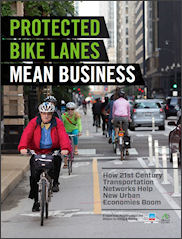 About a year ago, I hosted a couple of brain-storming sessions to develop talking points for building a bicycle infrastructure in the Richmond region. The goal was to make a hard-nosed business case that investing in bikes would boost economic growth and bolster public health. (See “Making the Public Health Case for Bicycles” and “Bicycles and Economic Development.”)
About a year ago, I hosted a couple of brain-storming sessions to develop talking points for building a bicycle infrastructure in the Richmond region. The goal was to make a hard-nosed business case that investing in bikes would boost economic growth and bolster public health. (See “Making the Public Health Case for Bicycles” and “Bicycles and Economic Development.”)
If only my fellow brain stormers and I had had access to “Protected Bike Lanes Mean Business,” we could have made an even stronger case. This report by PeopleForBikes and the Alliance for Biking and Walking touches on all the themes that we developed, and more. Broadly speaking, the authors see four ways by which bike lanes boost economic growth (and I quote verbatim here):
Fueling redevelopment to boost real estate value. As city populations grow, motor vehicle congestion increases. New roads are rarely an option in mature cities. Protected bike lanes bring order and predictability to streets and provide transportation choices while helping to build neighborhoods where everyone enjoys spending time. By extending the geographic range of travel, bike lanes help neighborhoods redevelop without waiting years for new transit service to debut.
Helping companies score talented workers. Savvy workers, especially Millennials and members of Generation X, increasingly prefer downtown jobs and nearby homes. Because protected bike lanes make biking more comfortable and popular, they help companies locate downtown without breaking the bank on auto parking space, and allow workers to reach their desk the way they increasingly prefer: under their own power.
Making workers healthier and more productive. From DC to Chicago to Portland, the story is the same: people go out of their way to use protected bike lanes. By creating clear delineation between auto and bike traffic, protected bike lanes get more people in the saddle — burning calories, clearing minds, and strengthening hearts and lungs. As companies scramble to lower health care costs, employees who benefit from the gentle exercise of pedaling to work help boost overall hourly productivity and cut bills.
Increasing retail visibility and sales volume. In growing urban communities, protected bike lane networks encourage more people to ride bikes for everyday trips. And when people use bikes for errands, they’re the idea kind of retail customers: regulars. They stop by often and spend as much or more per month as people who arrive in cars. Plus, ten customers who arrive by bike fit in the parking space of one customer who arrives by car.
The only caveat that I would add is the same one I would add to investing in roads, highways and mass transit: All bike lane projects should be subjected to Return on Investment analysis and compete on an ROI basis with all other transportation modes.
— JAB


